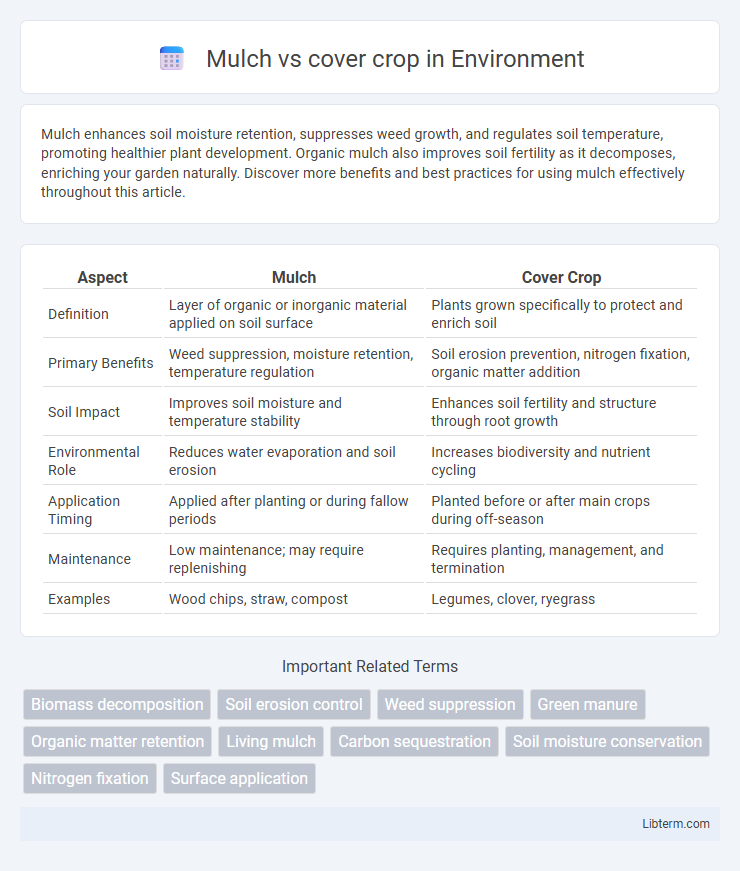Mulch enhances soil moisture retention, suppresses weed growth, and regulates soil temperature, promoting healthier plant development. Organic mulch also improves soil fertility as it decomposes, enriching your garden naturally. Discover more benefits and best practices for using mulch effectively throughout this article.
Table of Comparison
| Aspect | Mulch | Cover Crop |
|---|---|---|
| Definition | Layer of organic or inorganic material applied on soil surface | Plants grown specifically to protect and enrich soil |
| Primary Benefits | Weed suppression, moisture retention, temperature regulation | Soil erosion prevention, nitrogen fixation, organic matter addition |
| Soil Impact | Improves soil moisture and temperature stability | Enhances soil fertility and structure through root growth |
| Environmental Role | Reduces water evaporation and soil erosion | Increases biodiversity and nutrient cycling |
| Application Timing | Applied after planting or during fallow periods | Planted before or after main crops during off-season |
| Maintenance | Low maintenance; may require replenishing | Requires planting, management, and termination |
| Examples | Wood chips, straw, compost | Legumes, clover, ryegrass |
Introduction to Mulch and Cover Crops
Mulch consists of organic or inorganic materials spread over soil to retain moisture, regulate temperature, and suppress weeds, enhancing plant growth and soil health. Cover crops are specific plants grown primarily to improve soil fertility, reduce erosion, and increase organic matter through root systems and biomass. Both practices contribute to sustainable agriculture by improving soil structure, nutrient cycling, and ecosystem resilience.
Defining Mulch and Its Types
Mulch is a protective layer of material applied to the soil surface to conserve moisture, regulate temperature, suppress weeds, and improve soil health. Common types of mulch include organic options like straw, wood chips, bark, leaves, grass clippings, and compost, as well as inorganic materials like plastic sheeting, landscape fabric, and gravel. Each type of mulch offers distinct benefits, with organic mulches enriching soil fertility as they decompose and inorganic mulches providing durable weed barriers.
What Are Cover Crops?
Cover crops are plants grown primarily to protect and enhance soil health by preventing erosion, improving soil structure, and increasing nutrient content. Unlike mulch, which is a protective layer applied on the soil surface, cover crops actively grow and contribute organic matter, fix nitrogen, and suppress weeds. Common cover crops include legumes like clover, grasses like rye, and brassicas such as mustard, each selected for specific soil benefits and climate adaptability.
Key Benefits of Mulching
Mulching improves soil moisture retention by reducing evaporation, which leads to healthier plant growth and reduced irrigation needs. It also suppresses weed growth, minimizing competition for nutrients and reducing the need for herbicides. Furthermore, mulch regulates soil temperature and enhances soil structure by adding organic matter as it decomposes.
Advantages of Using Cover Crops
Cover crops improve soil fertility by fixing nitrogen and increasing organic matter, which enhances nutrient availability for subsequent crops. They prevent soil erosion and suppress weeds through dense root systems and ground coverage, reducing the need for herbicides. Cover crops also boost soil microbial activity and moisture retention, leading to healthier plants and higher yields compared to mulch alone.
Soil Health: Mulch vs Cover Crop
Mulch enhances soil health by conserving moisture, regulating temperature, and reducing erosion, while cover crops improve soil structure, increase organic matter, and fix nitrogen to boost fertility. Mulch acts as a protective layer on the soil surface, minimizing weed growth and preventing nutrient runoff. Cover crops promote microbial activity and root development, leading to long-term soil resilience and productivity.
Moisture Retention and Water Management
Mulch effectively reduces soil evaporation by forming a protective barrier that maintains consistent moisture levels, while cover crops improve water infiltration and retention through root structure and organic matter addition. Both methods contribute to enhanced water management, but mulch provides immediate surface moisture conservation, whereas cover crops promote longer-term soil moisture stability. Integrating mulch and cover crops optimizes moisture retention and supports sustainable water use in agricultural systems.
Weed Suppression Comparison
Mulch acts as a physical barrier blocking sunlight, effectively preventing weed seed germination and growth by shading the soil surface. Cover crops suppress weeds by outcompeting them for resources such as nutrients, water, and light through rapid biomass production and canopy development. Research shows cover crops can reduce weed density by up to 70%, while organic mulches provide immediate but often shorter-term weed control depending on thickness and decomposition rate.
Cost and Labor Considerations
Mulching typically requires an upfront purchase of materials like wood chips or straw, leading to moderate initial costs but minimal ongoing labor beyond application. Cover cropping involves seed expenses and more intensive labor for planting and termination, increasing overall time investment and variable costs. Farmers often weigh mulch's ease of use against cover crops' potential long-term soil health benefits when balancing labor and budget constraints.
Choosing the Right Option for Your Garden
Mulch improves soil moisture retention and reduces weed growth by creating a protective barrier, while cover crops enhance soil fertility and structure by fixing nitrogen and increasing organic matter. The right choice depends on your garden's needs; select mulch for immediate weed control and moisture conservation, or cover crops for long-term soil health and nutrient enrichment. Combining both methods can optimize garden productivity by balancing soil protection and nutrient cycling.
Mulch Infographic

 libterm.com
libterm.com